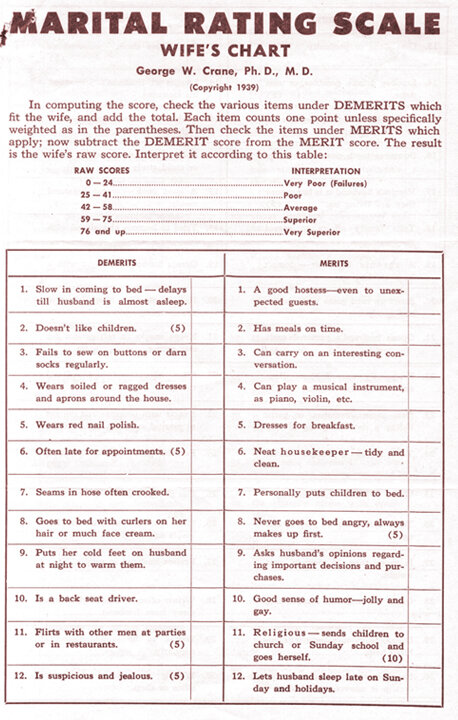David Baxter PhD
Late Founder
Husbands, rate your wives
By Nick Joyce and David B. Baker, PhD
American Psychological Association, Monitor on Psychology
Volume 39, No. 5 May 2008
A psychologist's attempt to improve marriages provides an interesting glimpse into the social norms of the 1930s—and into one of the first scientific matchmaking services.
Some of psychology's most interesting artifacts reflect not only the zeitgeist of the times but the personalities of the psychologists behind them. One such example is the Marital Rating Scale—Wife's Chart, a test developed in the late 1930s by George W. Crane, MD, PhD, (1901–95) of Northwestern University, who ran a counseling practice, wrote a syndicated national newspaper column called The Worry Clinic and started his own matchmaking service.
The test was designed to give couples feedback on their marriages. Either husbands or wives could take the test, which rated wives in a variety of areas. For instance, if your wife "uses slang or profanity," she would get a score of five demerits. On the other hand, if she "reacts with pleasure and delight to marital congress," she would receive 10 merits. The test taker would add up the total number of merits and demerits to receive a raw score, which would categorize the wife on a scale from "very poor" to "very superior."
Although most people who read the test today find it humorous and obviously dated, Crane did attempt to make it scientific. His method was to interview 600 husbands on their wives' positive and negative qualities. Then he listed the 50 demerits and merits that arose most frequently. Crane, did admit to using a personal bias in weighting the items that he thought were most important in marriage.
Crane's views on marriage were well-received at the time. He had 12 bulletins on the subject that could be purchased through mail order. In 1957, he started the Scientific Marriage Foundation—sort of a low-tech version of the popular matchmaking Web site eHarmony—which took a "scientific" approach to marriage. Applicants filled out forms that were sent to an IBM sorting machine that matched them in to compatible pairs. During its three years of existence, the foundation claimed to have set up more than 5,000 marriages.
Of course, gender relations have come a long way since Crane's work, but many of his methods are still used for matchmaking today: People still rate their partners' characteristics as positive or negative, though the standards have changed. Husbands may not expect the same behaviors from their wives anymore, but some of its items—such as "squeezing toothpaste from the top"— may still resonate with us today.

By Nick Joyce and David B. Baker, PhD
American Psychological Association, Monitor on Psychology
Volume 39, No. 5 May 2008
A psychologist's attempt to improve marriages provides an interesting glimpse into the social norms of the 1930s—and into one of the first scientific matchmaking services.
Some of psychology's most interesting artifacts reflect not only the zeitgeist of the times but the personalities of the psychologists behind them. One such example is the Marital Rating Scale—Wife's Chart, a test developed in the late 1930s by George W. Crane, MD, PhD, (1901–95) of Northwestern University, who ran a counseling practice, wrote a syndicated national newspaper column called The Worry Clinic and started his own matchmaking service.
The test was designed to give couples feedback on their marriages. Either husbands or wives could take the test, which rated wives in a variety of areas. For instance, if your wife "uses slang or profanity," she would get a score of five demerits. On the other hand, if she "reacts with pleasure and delight to marital congress," she would receive 10 merits. The test taker would add up the total number of merits and demerits to receive a raw score, which would categorize the wife on a scale from "very poor" to "very superior."
Although most people who read the test today find it humorous and obviously dated, Crane did attempt to make it scientific. His method was to interview 600 husbands on their wives' positive and negative qualities. Then he listed the 50 demerits and merits that arose most frequently. Crane, did admit to using a personal bias in weighting the items that he thought were most important in marriage.
Crane's views on marriage were well-received at the time. He had 12 bulletins on the subject that could be purchased through mail order. In 1957, he started the Scientific Marriage Foundation—sort of a low-tech version of the popular matchmaking Web site eHarmony—which took a "scientific" approach to marriage. Applicants filled out forms that were sent to an IBM sorting machine that matched them in to compatible pairs. During its three years of existence, the foundation claimed to have set up more than 5,000 marriages.
Of course, gender relations have come a long way since Crane's work, but many of his methods are still used for matchmaking today: People still rate their partners' characteristics as positive or negative, though the standards have changed. Husbands may not expect the same behaviors from their wives anymore, but some of its items—such as "squeezing toothpaste from the top"— may still resonate with us today.


